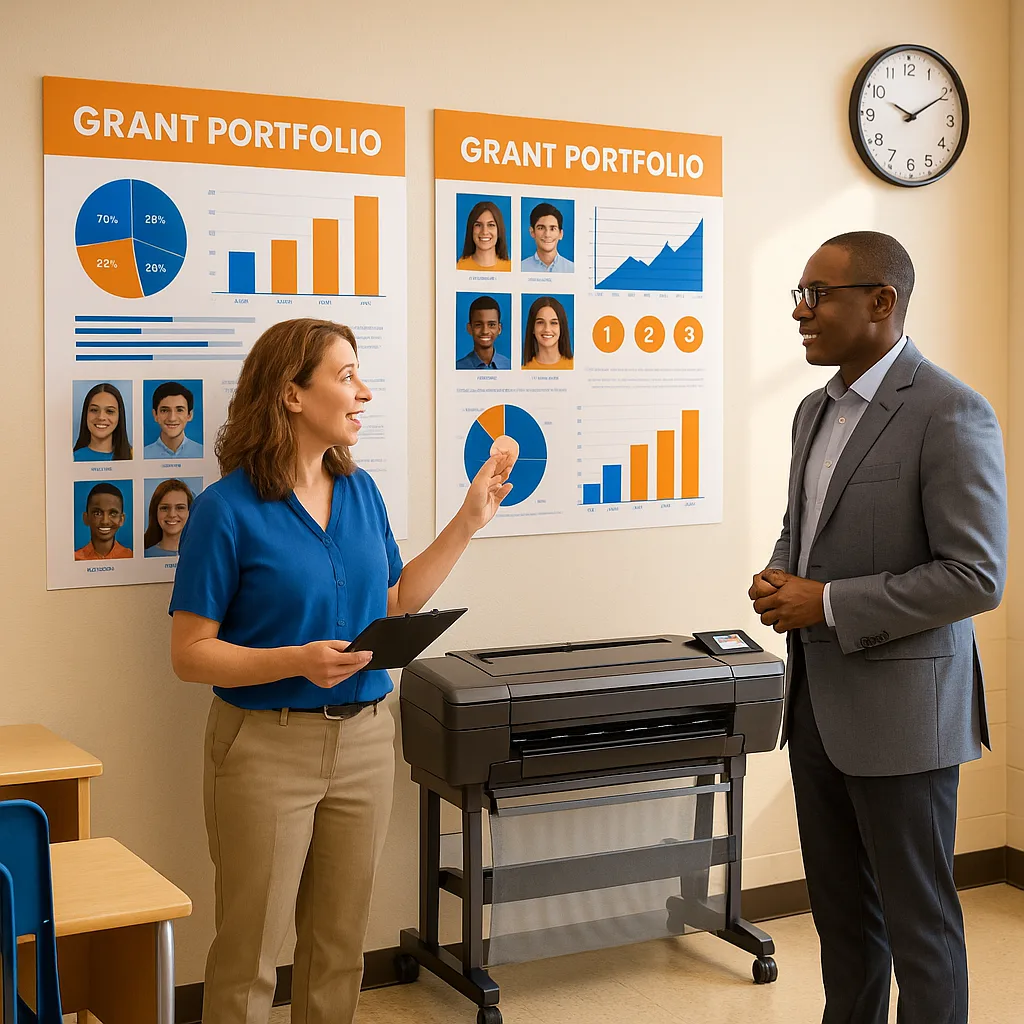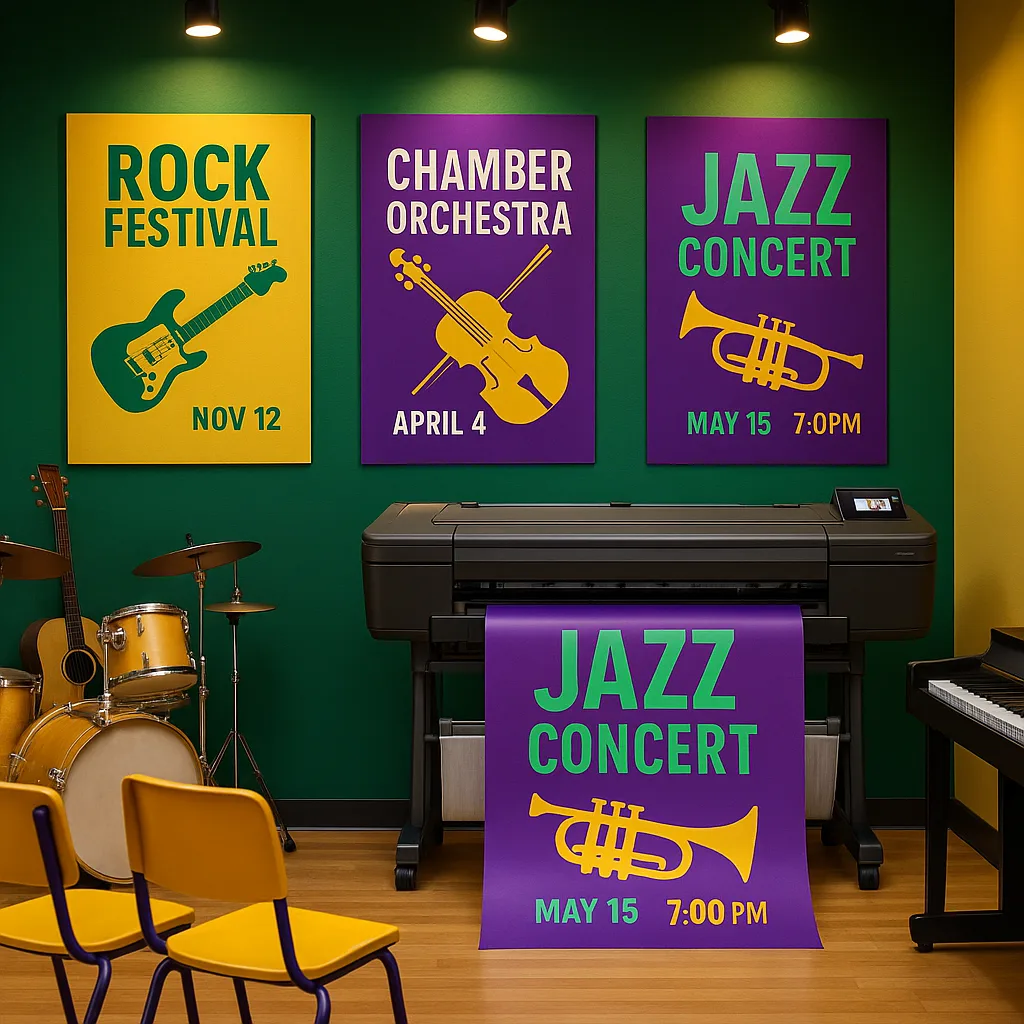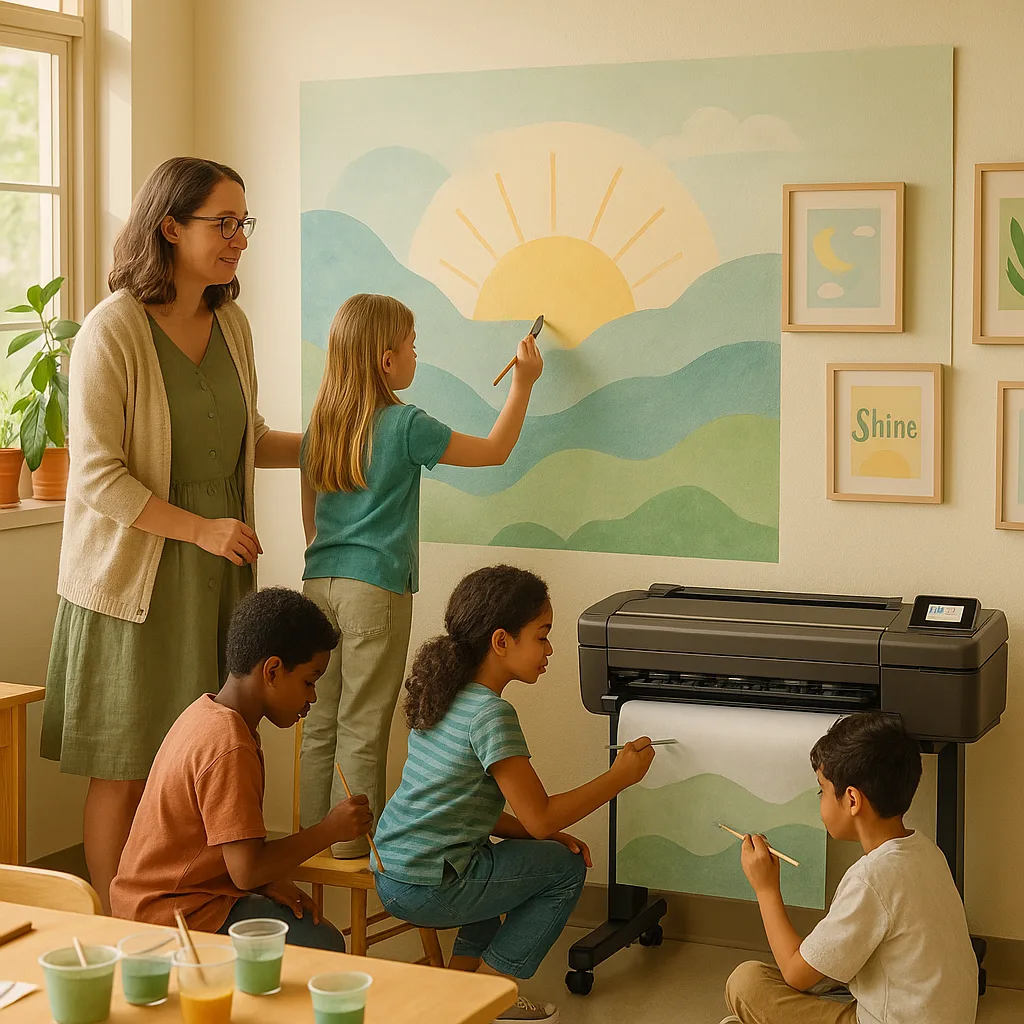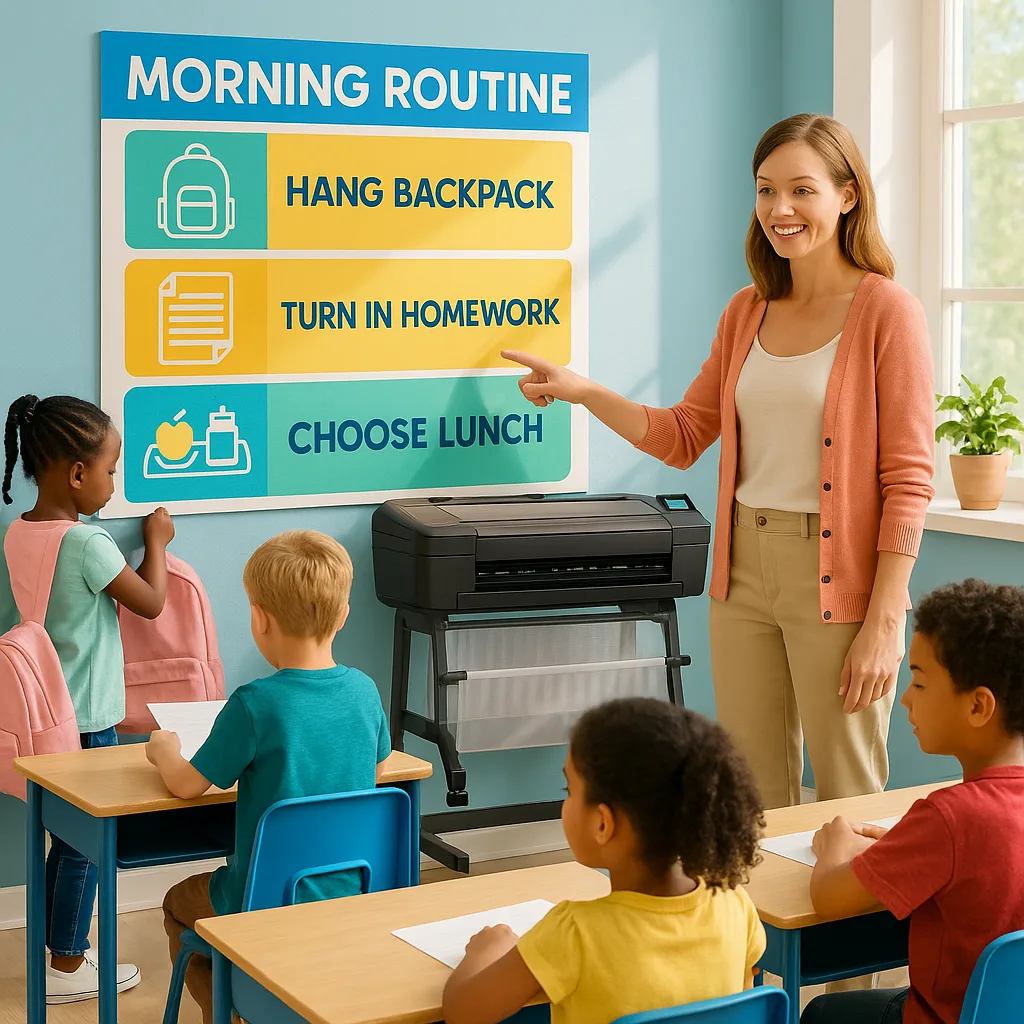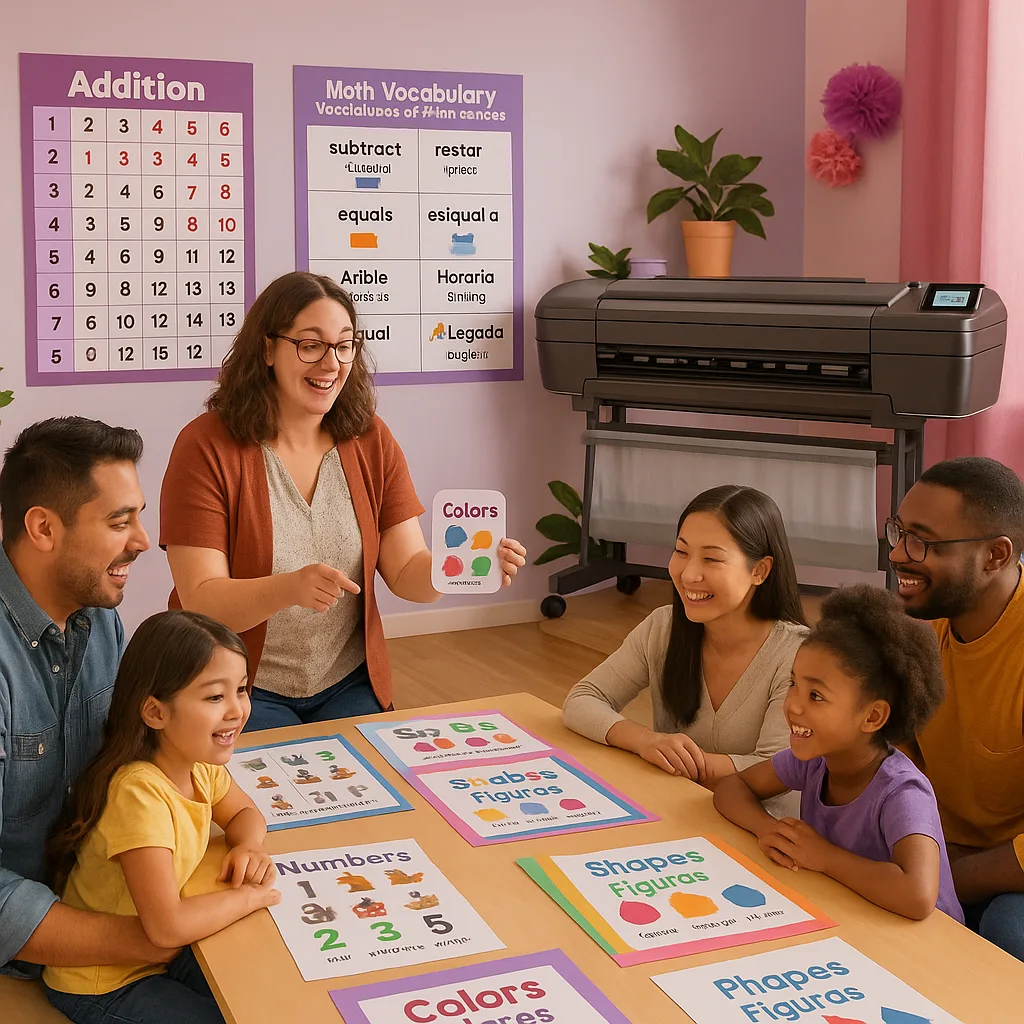
Picture this: Maria, a kindergartener who speaks Spanish at home, enters our school library for the first time. Instead of feeling overwhelmed by endless shelves and English-only signs, she confidently navigates to the picture book section, guided by colorful animal symbols and rainbow pathways on the floor. This transformation happened when we invested in a poster maker machine for school library navigation, revolutionizing how our youngest learners find their way through our literary landscape.
Understanding the Challenge: When Words Aren’t Enough
Recent research from the International Literacy Association reveals that 42% of kindergarten through second-grade students experience library anxiety, primarily due to navigation difficulties. For English language learners and pre-readers, traditional text-based signage creates barriers rather than bridges. The solution? A comprehensive visual wayfinding system that speaks a universal language of symbols, colors, and intuitive design.
When schools implement strategic visual navigation systems, student library usage increases by an average of 68%, according to a 2023 study by the School Library Journal. More importantly, these systems foster independence and confidence in our most vulnerable learners—those who can’t yet decode written words but desperately want to explore the world of books.

The Research Behind Symbol-Based Wayfinding
Dr. Sandra Chen’s groundbreaking 2022 study at UCLA demonstrated that children as young as three can successfully navigate spaces using symbol-based systems with 85% accuracy. Her research identified five key principles for effective visual wayfinding:
1. Consistency is Key
Every symbol must appear identically throughout the space. When we use our Education Express 24″ Poster Maker Package A, we ensure perfect replication across all signage.
2. Cultural Universality
Symbols should transcend cultural boundaries. A book icon means “reading” in every language, while a paintbrush universally represents art.
3. Progressive Disclosure
Start with broad categories (fiction/nonfiction) before introducing subcategories (mystery/adventure).
4. Multi-Sensory Engagement
Combine visual elements with tactile features when possible. Raised symbols on posters allow vision-impaired students to participate.
5. Redundant Coding
Never rely on a single wayfinding element. Combine symbols with colors, shapes, and placement patterns for maximum clarity.
These principles form the foundation of inclusive library design, ensuring every student can navigate independently regardless of reading ability or language background.
Creating Your Poster Maker Machine for School Library Navigation System
Building an effective visual wayfinding system requires thoughtful planning and the right tools. Here’s how to transform your library into an inclusive, navigable space that welcomes all learners.
Step 1: Conduct a Navigation Audit
Before creating any signage, observe how students currently navigate your library. Note confusion points, frequently asked questions, and areas where students hesitate. This baseline data will guide your design decisions and help measure improvement after implementation.
of pre-readers successfully navigate with symbols
increase in library usage with visual wayfinding
of ELL students prefer symbol-based navigation
reduction in library anxiety reported
Step 2: Design Your Symbol System
Your symbol vocabulary should be intuitive yet comprehensive. Start with these essential categories:
• Fiction sections: Use familiar characters or story elements
• Nonfiction areas: Employ recognizable real-world objects
• Activity zones: Incorporate action-based symbols
• Grade-level sections: Combine numbers with age-appropriate imagery
• Language collections: Feature flag symbols alongside welcoming graphics
The Lifetime Design Service included with Poster Studio Express systems provides expert guidance in creating culturally sensitive, universally understood symbols that resonate with your diverse student population.
Step 3: Implement Strategic Color Coding
Color serves as a powerful secondary navigation tool, but it must never be the sole wayfinding element (considering colorblind students). Research from the Journal of Environmental Psychology indicates that consistent color coding can reduce navigation time by up to 40%.
Color Psychology in Library Wayfinding
Cool Blues & Greens
Fiction & Imagination
Calming, creative spaces
Warm Oranges & Yellows
Nonfiction & Discovery
Energizing, factual areas
Purple & Pink Accents
Special Collections
Unique, featured sections
Addressing Poster Making Machine Price Concerns Through Strategic Implementation
Many librarians worry about the poster making machine price when considering a comprehensive wayfinding overhaul. However, the long-term benefits far outweigh initial investments. Schools using in-house poster production report saving an average of $3,000 annually compared to outsourcing signage needs.
The Education Studio 36″ Duplicator Poster Maker Package A+ offers exceptional value for libraries serving diverse populations. Its ability to produce weather-resistant materials means outdoor wayfinding elements last years without replacement.
Consider these cost-saving strategies:
• Start with high-traffic areas and expand gradually
• Use modular designs that allow updates without complete replacement
• Leverage the included design software to create templates for consistency
• Partner with art classes to design symbols (educational and economical!)
• Apply for literacy grants that often cover wayfinding improvements
Real-World Success: Harrison Elementary’s Transformation
When Harrison Elementary invested in a poster maker machine for school library navigation, they saw immediate results. Library Media Specialist Jennifer Martinez shares: “Our ELL population went from avoiding the library to becoming our most frequent visitors. The visual system we created removed language barriers completely.”
Their implementation included:
• Animal-themed section markers (bears for beginning readers, eagles for advanced)
• Floor pathways in rainbow colors leading to different genres
• Multilingual welcome posters at child eye-level
• Interactive “find the book” visual scavenger hunts
• Parent guides with matching symbols for home reinforcement
Within one semester, circulation among pre-readers increased 127%, and library anxiety assessments showed a 76% improvement in student comfort levels.
Advanced Strategies for Maximum Impact
Once basic wayfinding is established, these advanced techniques can further enhance navigation success:
Sequential Visual Storytelling
Create poster sequences that tell a story as students move through the library. For instance, a caterpillar at the entrance gradually transforms into a butterfly near the checkout desk, subtly guiding traffic flow while reinforcing transformation through reading.
Interactive QR Integration
While maintaining symbol-based navigation, add QR codes that link to audio descriptions in multiple languages. This supports both pre-readers and visually impaired students without cluttering the visual design.
Seasonal Adaptations
Use your poster making machine’s flexibility to create seasonal overlays. During Hispanic Heritage Month, add culturally relevant symbols alongside permanent wayfinding. This keeps navigation fresh while honoring diversity.
Student Ambassador Programs
Train older students as “library navigators” who wear badges matching wayfinding symbols. They become living guides who reinforce the visual system while building leadership skills.
Ready to Transform Your Library?
Every student deserves to feel confident navigating their library. With the right visual wayfinding system, you can create that magical moment when a pre-reader independently finds their favorite picture book or an English language learner discovers resources in their home language.
Measuring Success: Data-Driven Wayfinding Assessment
To justify your poster making machine price investment and demonstrate impact, establish clear metrics:
• Pre/post navigation time studies
• Student confidence surveys (use emoji scales for pre-readers)
• Circulation data by student demographics
• Library anxiety assessments
• Teacher feedback on student independence
• Parent engagement measurements
Document these improvements to support future funding requests and share success stories with your school community. The data consistently shows that inclusive wayfinding systems deliver remarkable returns on investment—both financially and educationally.
Final Thoughts: Building Bridges, Not Barriers
The hidden language of library spaces speaks volumes about our commitment to inclusive education. When we invest in comprehensive visual wayfinding systems, we’re not just hanging posters—we’re building bridges to literacy for every child who enters our doors.
Your poster maker machine for school becomes more than equipment; it transforms into a tool for equity, ensuring that language barriers, reading levels, or learning differences never prevent a child from discovering the magic within library walls. Because every student—whether they’re decoding their first words or navigating a new language—deserves to feel at home among books.
Remember, the most successful library isn’t measured by its collection size or technology offerings, but by how confidently its youngest, most vulnerable users can find exactly what they need. Visual wayfinding makes that confidence possible for all.


